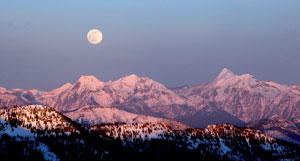For more than 25 years Whitefish photographer Kathy Sullivan, owner of Mountain Photography, has snapped shots of downhill racers clipping gates at 80 mph and screaming whitewater rafters paddling Pinball rapids on the Middle Fork. As the digital revolution swept photography, she swapped film for pixels – rekindling her enjoyment as her art improved.
“Like every pro, I resisted digital for a long time,” Sullivan says. “I got so comfortable with the old camera.” Now, she revels in switching camera settings rather than changing film rolls between portraits and scenery. As she upgraded her business to digital, she also taught the art. “I hired people for their personalities, not their photo skills, and then taught them to be photographers,” she explains. For Sullivan, the next step is logical – launching a series of public digital photography workshops.
But even with digital point-and-shoots, she says, “Most people don’t know how to use more than just ‘auto.’” Her two-day classes in Whitefish aim to walk participants past the “auto” wall into using all camera features. The course is split into two independent sessions.
The first nails how to use digital camera features for different types of pictures: scenery, portraits, action and low light. Since Sullivan found her photographers mastered how to shoot good photos with hands-on practice, much of the three-hour session includes shooting photos, then studying them. With digital photography, results are immediate. “Digital makes the content better with immediate viewing. You can correct mistakes right there,” says Sullivan, who for years shot multiple frames in case a subject’s eyes were closed, only seeing results the next day as they emerged from the darkroom. Once the participants throw their shots into a computer, they’ll analyze their artistic merits, learning how to achieve certain results.
 |
|
Photo courtesy of Kathy Sullivan |
Shooting digital doesn’t guarantee a good photo. “But you can manipulate a shot into a good photo after the fact. Now everyone can have a darkroom on the computer,” says Sullivan, noting that most people shoot photos for memory rather than publication. Her second 90-minute class will enhance, manipulate and archive photos with Photoshop Elements.
Like many photographers converting from film to digital, Sullivan watched her photo volume catapult. This month, she shot 1,800 photos in one three-day ski race. “Many people think, ‘what the heck, it won’t cost me to shoot more photos,’” she says. The problem then becomes archiving photos – learning to edit and dump. “You need to be selective in what you keep and don’t keep,” she says.
Digital cameras have also contributed to a rise in amateur artists. “These days, there are a lot more amateur photographers out there and a lot more trying to move from amateur to pro,” she says. While her first classes target beginners, but are open to any photo buffs, future classes may pick up more advanced tricks for photographers who are further along.
Sullivan’s first photography classes start in Whitefish on March 29. She plans to repeat the sessions frequently with several more scheduled once every two-to-three weeks throughout the summer. Students may opt for single sessions, or even split sessions between two different weeks. Individual sessions cost $65-85; both sessions cost $140.
Sullivan confesses that digital photography bumped up her own personal pleasure and improved her own photos – especially action shots. “It’s the immediate education and gratification the digital affords,” she says. “How did I live before digital?”